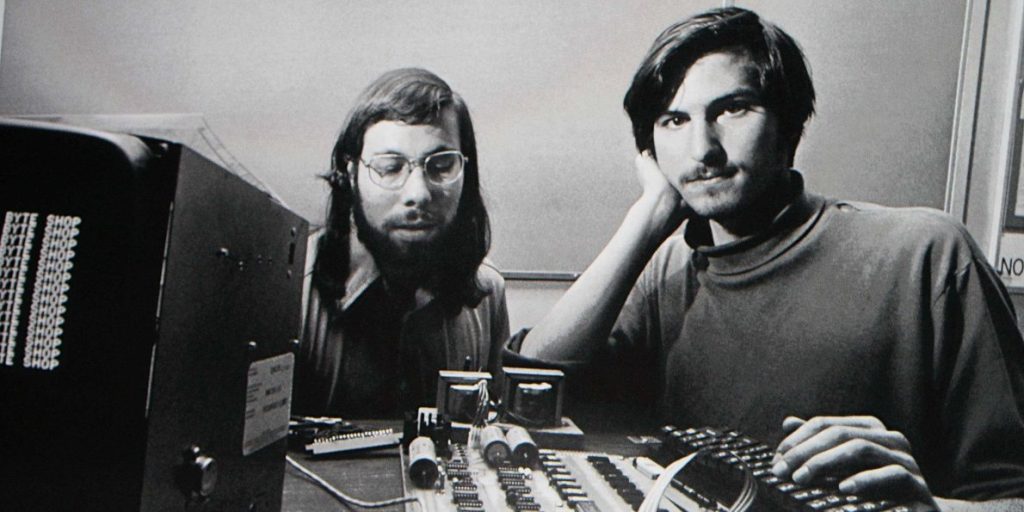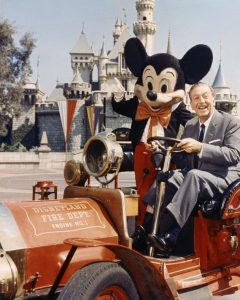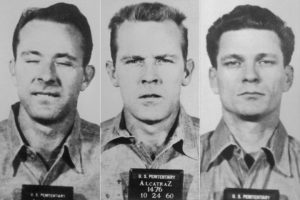Winner of the Fall 2017 StMU History Media Award for
Best Article in the Category of “People”
It was a sunny summer day. A sea of graduates, proud parents, family members, and faculty had their sights fixed on a bony and haggard individual. It seemed age had already taken possession of his body, making him look somewhat fragile and weak. Yet, he radiated forcefulness. The man was none other than Steve Jobs, ready to deliver Stanford’s Class of 2005 Commencement Speech. By that year, Jobs had gone through many hardships—he had been fired from the company he started, and he had undergone intricate medical procedures due to pancreatic cancer, just to name a few. Amidst the tragedies in his life, he transmitted nothing but the serenity of a man that had accomplished what he desired in life. One of his initial remarks was “Your work is going to fill a large part of your life, and the only way to be truly satisfied is to do what you believe is great work. And the only way to do great work is to love what you do. If you haven’t found it yet, keep looking. Don’t settle. As with all matters of the heart, you’ll know when you find it.”1 However, how exactly did Jobs find his dream job? Specifically, what was the genesis of Apple Inc?

“I did go to college… [and] after six months, I couldn’t see the value in it. I had no idea what I wanted to do with my life and no idea how college was going to help me figure it out.”4 In his academic hiatus, Steve encountered many things. He experienced psychedelic drugs, and sought to find spiritual enlightenment in India. He rekindled a friendship that would later serve as catalyst for the creation of the most powerful electronic company of all time, Apple Inc. His friend was Steve Wozniak, a talented, self-taught electronics engineer, whom Jobs had met in his high school years through common friends.5 Like himself, Steve Wozniak was an electronics enthusiast. After having part-time jobs with Atari and Hewlett-Packard, Jobs had found his passion—anything electronics.6 “I was lucky—I found what I loved to do early in life.”7 The two Steves, in love with computers, began their first commercial venture in 1975, when Jobs was only twenty years old.8
Their first creations were called “blue boxes”—electronic boxes that allowed anyone to make cost-free long-distance phone calls.9 Jobs invested $40 in parts and sold the boxes door-to-door in college dorm rooms for $150 apiece, splitting the profits with Wozniak.10 Although their first creation had to be shut down because of its illicit intentions, it proved that the two Steves were perfect business partners. Many attribute Apple’s early success to the natural connection the two Steve’s shared. Wozniak has commented,”we had so much in common. Normally, it was hard for me to explain to people the kind of designs I worked with, but Steve got it right away.”11 Similarly, Jobs explained, “He was the only person I met who knew more about electronics than me.”12 Despite their different personalities, they complemented each other in a wonderful manner. Steve Wozniak contributed with his technological savvy, and Steve Jobs with his entrepreneurial charisma. Aware of this powerful interrelation, they decided to take their collaborative efforts to the next level.

Jobs and Wozniak regularly attended Homebrew Computer Club (HCC), where they swapped ideas with other hobbyists who dreamed of building their own computers.13 It was there that they recognized the market for smaller, cheaper, intuitive, and accessible computer machines for everyday consumers. In his very first HCC meeting, Wozniak recalls, “the complete vision of a personal computer suddenly appeared in my head. That night I began to make sketches on paper of what later became known as the Apple I.14 Just as he had with the blue boxes, Jobs quickly recognize the potential to profit from a computer that Wozniak had designed to show off at the HCC.15
Their new venture—the Apple I. Jobs convinced Wozniak that they should sell the computers as a product. “Steve [Jobs] didn’t do one circuit of design for the first computer…but it was his idea to sell them,” Wozniak recalls.16 In order to finance their bold creation, Jobs parted with his red and white Volkswagen bus for $1,500 and Wozniak with his beloved HP-65 programmable calculator for $250.
Every day after that, Wozniak would work on the first prototype in his Hewlett-Packard cubicle, spreading the pieces out and deciding where they should be placed and welded.17 By 1975, “Woz” had successfully created the first personal computer with a typewriter-like keyboard able to connect to a regular TV as a screen. Just like that, the archetype of the modern personal computer and the start-up of the biggest company in the world was up and running. The two Steves were ready to take their simple computer to the market, but first, they needed a name for their company. As the two drove along Highway 85 between Palo Alto and Los Altos, Jobs blurted out “I’ve got a name: Apple Computer.”18 It was Jobs who came up with “Apple.” He thought the name sounded “fun, spirited and not intimidating.” Although they tried to think of more technical sounding names, nothing was able to beat “Apple Computer.”

Realizing that Apple would be hopelessly deadlocked if they disagreed on any major issues, the two sought someone who could serve as a tiebreaker and help get the company off the ground. That man was Ronald G. Wayne, a video game maker’s chief draftsman. Jobs enticed Wayne to become a partner in Apple by offering ten percent interest in the company, with the remainder split between Jobs and Wozniak. The three formally filed the partnership papers for Apple Computer Company on April Fool’s Day, 1976.19 By 1976, Apple Inc was open for business, and Jobs was only twenty-one years old. Wozniak conceived of a series of user-friendly personal computers, and—with Jobs in charge of marketing—Apple set the list price of the original 4K Apple I at $666.66 each.20 Immediately, Jobs began hustling up customers. Paul Jay Terrel—owner of the first retail computer store chain in the country “Byte Shop”—agreed to buy fifty computers for $500 each, cash on delivery.
The order was placed, the only problem—they had no working station. In a daring move, 11161 Crist Drive in Los Altos (Steve’s home), became the assembly center of the Apple I. The 24-by-24 ft cramped space in Jobs’s garage was transformed into an impromptu workshop. The two Steve’s had thirty full days to complete the Byte Shop’s request. Having no employees, and very little time, the two Steves recruited all available hands, from college students to Jobs’ pregnant sister Patty. Around ten workers were roped in to sit at a kitchen table to solder parts and set up boards. Exceedingly long working hours. Enormous amounts of caffeine. Countless failed models. No sleep. The small garage became so labor intensive that Paul Jobs (Steve’s father), had to stop repairing old cars so that the Apple kids could have all of the garage for themselves. Defying all odds, however, the company’s first batch of Apple I’s was completed within the month. With fifty Apple I’s completed, their first formal contract generated the rookie company a total of $25,000.21

Although there were a few bumps along the road, and a couple of not so successful products, it seemed that every year this company got better and better. They would go on to release trendsetting and ground-breaking products such as the Macintosh with its revolutionary mouse, the MacBook laptop computer, and the ubiquitous iPods, iPhones, and iPads that we cannot live without today. Ultimately, Apple became the most powerful electronic industry of all time. Its dominance is undisputed, generating a colossal $108.25 billion in sales today.
It is truly amazing to see how this company originated in a college drop out’s garage. Jobs’ early career success, dramatic ouster from the company he built, and ultimate transformation of Apple into one of America’s largest multi-billion dollar companies encapsulates the American dream.22 His untimely death left questions unanswered about the products he might have invented or what he might have accomplished later in life. Nevertheless, he made it clear to all that we should strive to reach our dreams, and work hard for them. As he said at the end of his Stanford speech, “Stay Hungry. Stay Foolish.”23
- Steve Jobs, “How to Live before you Die,” (Commencement Address, Stanford University, Stanford, June 12, 2005). ↵
- Walter Isaacson, Steve Jobs (New York: Simon & Schuster, 2011): 52. ↵
- Anna Wong, “A Lesson for Public Schools From Steve Jobs,” The Huffington Post, last modified October 9, 2012 https://www.huffingtonpost.com/anna-wong/steve-jobs-education_b_1762277.html. ↵
- Steve Jobs, “How to Live before you Die” (Commencement Address, Stanford University, Stanford, June 12, 2005). ↵
- International Directory of Company Histories, 2012, s.v. “Apple,” by Scott Lewis, Jeffrey L. Covell and Mark Lane. ↵
- Owen W. Linzmayer, Apple Confidential 2.0: The Definitive History of the World’s Most Colorful Company (San Francisco: No Starch Press, 2004): 2. ↵
- Steve Jobs, “How to Live before you Die,” (Commencement Address, Stanford University, Stanford, June 12, 2005). ↵
- Owen W. Linzmayer, Apple Confidential 2.0: The Definitive History of the World’s Most Colorful Company (San Francisco: No Starch Press, 2004): 2. ↵
- International Directory of Company Histories, 2012, s.v. “Apple,” by Scott Lewis, Jeffrey L. Covell, and Mark Lane. ↵
- Owen W. Linzmayer, Apple Confidential 2.0: The Definitive History of the World’s Most Colorful Company (San Francisco: No Starch Press, 2004): 3. ↵
- Walter Isaacson, Steve Jobs (New York: Simon & Schuster, 2011): 85. ↵
- Owen W. Linzmayer, Apple Confidential 2.0: The Definitive History of the World’s Most Colorful Company (San Francisco: No Starch Press, 2004): 3. ↵
- Owen W. Linzmayer, Apple Confidential 2.0: The Definitive History of the World’s Most Colorful Company (San Francisco: No Starch Press, 2004): 5. ↵
- Walter Isaacson, Steve Jobs (New York: Simon & Schuster, 2011): 170. ↵
- Owen W. Linzmayer, Apple Confidential 2.0: The Definitive History of the World’s Most Colorful Company (San Francisco: No Starch Press, 2004): 5. ↵
- Owen W. Linzmayer, Apple Confidential 2.0: The Definitive History of the World’s Most Colorful Company (San Francisco: No Starch Press, 2004): 6. ↵
- Walter Isaacson, Steve Jobs (New York: Simon & Schuster, 2011): 171. ↵
- Owen W. Linzmayer, Apple Confidential 2.0: The Definitive History of the World’s Most Colorful Company (San Francisco: No Starch Press, 2004): 6. ↵
- Owen W. Linzmayer, Apple Confidential 2.0: The Definitive History of the World’s Most Colorful Company (San Francisco: No Starch Press, 2004): 6. ↵
- Owen W. Linzmayer, Apple Confidential 2.0: The Definitive History of the World’s Most Colorful Company (San Francisco: No Starch Press, 2004): 7. ↵
- Owen W. Linzmayer, Apple Confidential 2.0: The Definitive History of the World’s Most Colorful Company (San Francisco: No Starch Press, 2004): 7. ↵
- Amy E. Hurley-Hanson and Cristina M. Giannantonio, “Academic Reflections on the Life and Career of Steve Jobs,” Journal of Business and Management, no. 1 (2013): 5. ↵
- Steve Jobs, “How to Live before you Die”(Commencement Address, Stanford University, Stanford, June 12, 2005). ↵




110 comments
Raymond Munoz
Disregarding the fact that this article feels a little like a biography, I think it is an interesting enlightenment of Steve Jobs and his triumph over the hardships of life. Now, having said that I feel that people think too highly of Jobs’ success because they try so hard to mimic and recreate his success for themselves. I believe the key to success does come from learning from previous successors, but it is important to remember to be yourself and accomplish your goals on your terms, not someone else’s. Steve Jobs is very inspiring and no one can ever take that away from him, but his life should not be anyone’s ultimate goal, the ultimate goal should be to become a better and more successful you.
Enrique Segovia
Steve Jobs’ story is another example of another college dropout becoming a billionaire. Nevertheless, Jobs dropping out of college did not stop his grit; he persistently sought for solutions to his problems and innovation was key for his success. Additionally, without the tech-wiz, Steve Wozniak, Jobs would not have been able to accomplish all by himself what Apple Inc. is today. Along with Woz, he concocted a multi-billion dollar company that is one of the leading technological companies in the world ever since its creation. This article brilliantly encompasses Jobs’ path to becoming one of the most influential men to exist and his company’s products, even though he already passed away, continue to mesmerize the world.
Daniela Martinez
As a person who owns Apple products hearing the story of how it all started still amazes me. The article acknowledges the highs, as well as the lows Jobs, faced in trying to release the first Apple product. I think that the most important thing this article did that most don’t is that Jobs didn’t do everything alone. He surrounded himself with individuals that were strong in the areas he wasn’t in order to have a successful team. Reading this gives readers the reassurance that one can accomplish their dreams with hard work and dedication.
Donte Joseph
Most of my life I had owned Apple products, but I would have never imagined how Apple all came to be let alone Steve Jobs’ upbringing and rise to success. Growing up I had always thought that making a good reliable living was made mostly through school, but Steve Jobs’ story proves that with knowledge and drive almost anything is possible. I learned so much about a man who wanted more for himself and who created one of the biggest companies today.
Maisie Favila
I find it so crazy how Steve Jobs built his career up. He was so dedicated to his work and it lead him to fame, fortune, and overall success. He continued to create something that topped the last product and sold it so quickly. I liked the article because I never really felt the need to look up how he came up with the name ‘Apple’ and why he decided to call it that. He was easily one of the greatest minds out there and he is proof that anything can be achieved with perseverance.
Jasmine Rocha
I liked the hook the article went with when they first told us how Steve was put up for adoption but his mother’s goal was for him to get a college degree to later on being a college dropout. The reason to what made him dropout was not because he was not capable, in fact, he seemed more than capable but the direction of his passion brought him away from the idea of college and to, later on, create Apple. Many people with beginnings similar to Steve relate in the many ideas of passion, perseverance, and creativity. He did not go on this journey alone and the mention of all the help gives young readers such as myself and those who have watched Steve speech is that success is not brought on your own but with the help of others and the connections you have with other people plus your potential. I feel like I have learned a lot from this article and that I should search for what I can grow to be happy doing.
Sabrina Hsu
This article was really interesting and informative and I’m glad I read it. It’s amazing how far Steve Jobs brought his company, and it continues to thrive even after he passed away. His whole life is so inspiring, he literally built his company with his own hands and that is just so amazing.
Brianna Ford
Okay, but the first thing I notice in this article was that the picture of steve jobs looks exactly like Ashton Kutcher. However, I never know Steve Jobs was put up for adoption. I do agree with him when he said that “educators were making him lose curiosity,” because that’s how I feel is what’s happening right now. I also never knew he traveled to india to find his spiritual enlightenment. This article did a very good job at being informative, I learned a lot more steve jobs today. He has done wonderful things.
Harashang Gajjar
This article describes the highs and lows of Steve jobs and the apple company which started from a small idea and place to a biggest company in the world. Article shows how hard struggle is done by Steve and if still he didn’t had died apple company would be at an another level today, but since he had seen his future he had made enough product for apple to run them for few years . An inspirational story of an extraordinary person.
Jabnel Ibarra
Steve Jobs’ humble beginnings serve as a reminder that anything is possible through passion and perseverance. It’s often difficult to imagine how a multimillion-dollar company that manufactures some of the world’s most popular devices saw its start in the garage of a young college dropout. Yet the story of its success and rise to fame paints the perfect image of an entrepreneur’s dream, a story of success through passion and hard work.